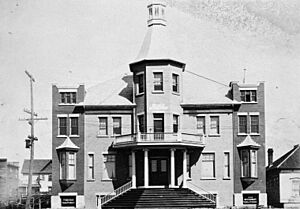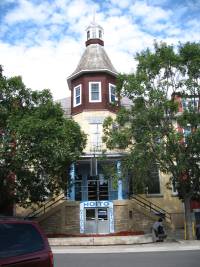Finnish Labour Temple facts for kids
Quick facts for kids Finnish Labour Temple |
|
|---|---|

As seen from the intersection of Bay and Algoma
|
|
| General information | |
| Type | Hall |
| Location | 314 Bay Street Thunder Bay, Ontario, Canada |
| Coordinates | 48°25′56″N 89°13′48″W / 48.43222°N 89.23000°W |
| Current tenants | The Hoito |
| Construction started | 1908 |
| Completed | March 1910 |
| Design and construction | |
| Architect | C.W. Wheeler |
| Official name: Finnish Labour Temple National Historic Site of Canada | |
| Designated: | 2011 |
The Finnish Labour Temple is a famous building in Thunder Bay, Ontario. People also call it the Big Finn Hall or Finlandia Club. It's a special place for Finnish-Canadian culture and community. You can find it at 314 Bay Street, in the area where many Finnish people settled.
Built in 1910, this building was once one of Canada's largest halls for workers. It was also a main spot for Finnish culture and politics in Northwestern Ontario. Today, the building is home to the historic Hoito Restaurant. It also has a museum, a big stage, a dance floor, and meeting rooms. The Finnish Labour Temple is a key location for the Bay Street Film Festival.
Contents
Building the Finnish Labour Temple
The idea for the Finnish Labour Temple came from two groups. These were the Finnish-American Workers' League Imatra #9 and the New Attempt Temperance Society. They joined together to form the Finnish Building Company.
The land for the hall was bought in June 1907. An architect named C.W. Wheeler drew the plans for the building in December 1908. The building officially opened its doors in March 1910. There were three days of opening parties to celebrate.
On top of the building, you can see a special message. It says "Labor Omnia Vincet." This Latin phrase means "labour conquers all."
Early Days of the Temple (1910–1914)
By 1910, the hall was known as the "Port Arthur Finnish Socialist's Local Temple." This was because a group of socialists owned most of the building. This group was linked to the Socialist Party of Canada. The Temperance Society became a part of this socialist group.
However, by December 1910, the Socialist Party removed groups that spoke other languages. So, in 1911, a new group formed called the Finnish Socialist Organization of Canada. This group then joined the Social Democratic Party of Canada.
In January 1910, the Finnish Building Company decided to rent the downstairs area. The Finnish Publishing Company moved in and stayed until 2012. They then moved to their own building next door. This company published the first Finnish-Canadian newspaper, Työkansa (The Working People). From 1910 to 1914, the basement also had several co-operative restaurants and a billiards room.
In September 1910, a big meeting was held at the Temple. The Trades and Labour Congress of Canada had its yearly convention there. A special book for the delegates praised the Finnish community. It noted their "industry, thrift and co-operative spirit."
World War I and Group Changes
During the First World War, the Canadian government made some foreign-language groups illegal. This caused many problems. Several Finnish newspapers were banned, and some leaders were arrested. Many Finnish workers then joined a new group called the One Big Union. This group soon owned most of the Finnish Building Company.
In 1919, a disagreement happened at a big meeting held at the Finnish Labour Temple. This meeting was for the One Big Union. The split was between two main groups of Finnish socialists. One group believed that workers needed a political group to make changes. The other group, called syndicalists, thought that changes could happen best through actions like a general strike.
Because of this disagreement, the Finnish socialists left the Temple. They bought their own building next door at 316 Bay Street, known as the "Little Finn Hall." They then joined the Communist Finnish Organization of Canada. The Finnish workers who stayed at the Finnish Labour Temple joined the Industrial Workers of the World. This happened after the Winnipeg General Strike and when the One Big Union became less active.
The Finnish Wobblies (1919 to the 1960s)
The Finnish workers who stayed at the Temple were called "Wobblies." They were linked to the Industrial Workers of the World (IWW). They also had a support group called Canadan Teollisuusunionistinen Kannatusliitto (CTKL). This group was important for starting and running the Hoito Restaurant. They also set up many People's Co-operative stores in the area.
The Finnish Labour Temple was the main office for the Canadian IWW for several years. It also had the Canadian news office for Industrialisti. This was the daily Finnish-language newspaper of the IWW. The Finnish Wobblies were also able to pay off the building's mortgage.
The IWW groups competed with other worker groups for members. They had local unions well into the 1940s. As younger generations became more like other Canadians, the IWW and CTKL groups changed. They became more like friendship and mutual aid societies for older members.
In the late 1960s, more Finnish people moved to Canada. A new group called the Finlandia Club of Port Arthur became the main owner of the hall. These new immigrants were different from the older Finnish-Canadians. They were not as interested in the political struggles of the past. Many of them were also not political or were more conservative. They connected left-wing ideas with difficult times like the Finnish Winter War.
The Finnish Labour Temple Today
The Finnish Labour Temple is still a very important building in Thunder Bay. It is the last remaining Finnish cultural centre in Canada. Because of its history, it has been named a National Historic Site of Canada. In 2015, a special ceremony took place to put up a plaque. This plaque officially marked the Temple as a National Historic Site.
The Hoito Restaurant was a very popular place for both locals and tourists. Recently, there has been more activity in the hall. A new group of local people are working to bring new life to this historic building. They hold events like a mojakka cooking competition. There is also an annual Finnish-Canadian art show during the summer solstice.
These new events, along with traditional dances and celebrations like St. Urho's Day, make the Finnish Labour Temple a unique place to visit in Thunder Bay. The Finlandia Association Of Thunder Bay used to own the building. Other local businesses like The Walleye Magazine and Seek Tours also had offices there.
In May 2020, the Finlandia Association decided to sell its property because of debt. This included the hall. A group called The Finlandia Co-operative tried to raise money to buy the building, but they were not successful. In October 2020, the building was sold to a private owner. The new owner said he wanted to reopen The Hoito Restaurant. He also plans to turn the rest of the building into "high-end apartments."



